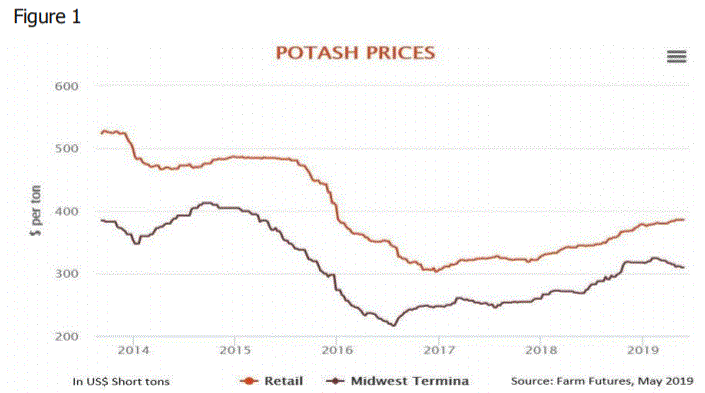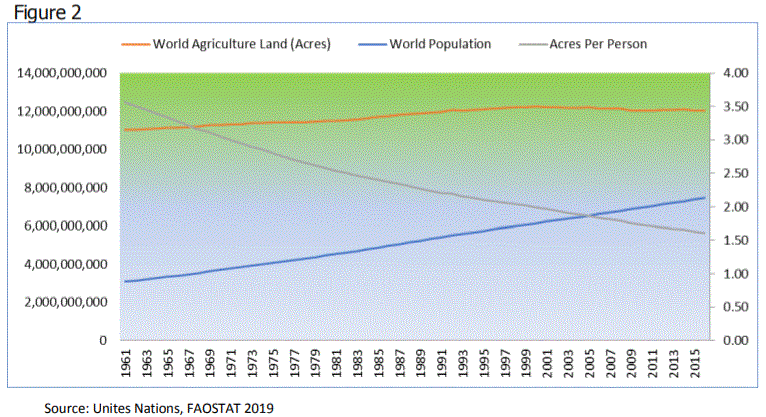The following content is excerpted from the news release of Gensource Potash Corp. dated June 4, 2019.
Global Potash Market
"Potash" is a general term that is applied to various forms of potassium-bearing fertilizer products. The most produced potash product, by far, is referred to as MOP (Muriate of Potash) and is produced and sold as high grade KCl (potassium chloride). KCl is a macro-nutrient (providing the "K", or potassium element within the fertilizer complex of N-P-K, Nitrogen-Phosphorus-Potassium) used to grow vital food crops for the ever-increasing world population.
The MOP market has experienced a significant recovery and resurgence of interest from 2016 through today. Potash price is now approximately 58% higher than its lows in late 2016 and world demand has increased markedly. According to the Food and Agriculture Organization of the United Nations (FAO), world demand in 2019 for potash, in all its forms, is forecast to reach 68 million tonnes. Potash demand has been strong with a 4% annual consumption growth over the last 5 years which is well above the long-term average of 2.8%. This growth is due to record demand from all major markets including Brazil, North America, China, India and Southeast Asia. The firmness in potash price is expected to remain as the growth in global demand will adequately absorb new supplies from the slow ramp ups in world-scale greenfield projects. See Figure 1.

Higher incomes (GDP growth) and population growth are the predominant factors stimulating higher demand for foodstuffs from the international marketplace, while trade liberalization and technological innovation have also facilitated trade expansion. World population growth is expected to slow to 1% p.a. over the next decade, compared to 1.3% in the previous decade. Developing countries continue to drive this growth, particularly Africa which is expected to have the fastest growth rate at 2.4% p.a. The Asia and Pacific region will account for nearly half the world's population, and India, with an additional 138 million people by 2027, is forecast to overtake China as the most populous country.
In global circles, the issue is termed "food security", which is a function of availability, quality and affordability. Amid increased uncertainties from recent trade disputes, world agricultural markets have, thus far, remained relatively stable, however many regions of the world experience significant challenges with food security. Figure 2 shows the fundamental causes: increasing world population and decreasing arable land base means that more food needs to be produced from an ever-decreasing land base.

Compounding this fundamental problem is the shift in many developing countries to a higher protein diet that drives an increase in meat consumption, which places additional pressure on the production of feed crops from the same shrinking arable land base. The result: more intensive agriculture, which will require more and more inputs to create the yields that will be needed.
Looking at potash, specifically, among the three macro-nutrients, it is clear that it is more concentrated with respect to production, with just 5 major producers accounting for 75-80% of production capacity and therefore market share. Growth in world-wide, new potash capacity appears to be slowing within the context of growth in demand. Major additions such as Eurochem's two projects in Russia, Nutrien's expansion at Rocanville and other properties in Saskatchewan, and the K+S Bethune mine (also in Saskatchewan) are being ramped up and absorbed into the market. Mosaic's K3 expansion is scheduled to be completed by 2024, at which time the K1 and K2 facilities are scheduled to be decommissioned, resulting in only a relatively small net increase in capacity from the Esterhazy, Saskatchewan "K" mines. Future significant projects, including BHP's Jansen project (Saskatchewan), remain uncertain, due to their enormous size and long development cycles. In addition, older and higher cost mines are coming off-line due to high operating costs, low reserve life and costly water management issues. Industry incumbents have suggested that reductions of up to 4 million tonnes per annum may occur due to existing mine ramp-downs or closures by the end of 2020.
According to Deloitte's "Tracking the Trends" (11th edition, 2019) annual mining report, today's mining climate requires companies to differentiate their business models to generate long-term value for not only shareholders but also to remain successful in the world communities in which they operate. It highlights that, in the past, mining companies anchored their strategic planning around producing the highest volume of ore at the lowest cost. The quest for superior returns through high volumes were underpinned by the expectation of constantly rising commodity prices.
The need for global growth in food supply and access to affordable food stuffs does not match with this model today. While quantities of crop inputs are expected to increase with the increase in overall food production, affordability starts to impact the old model of "bigger is better", because not only must we be bigger (i.e., produce more food) but we must also be more efficient: efficient in not only how we obtain the inputs (for instance the mining methods to obtain potash), but also in terms of how those inputs are most efficiently delivered to the end user - the farmer.